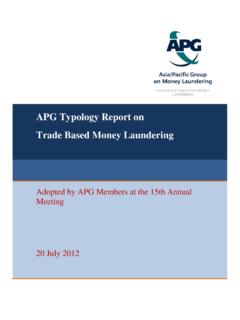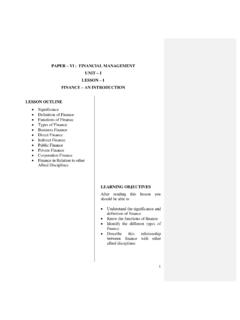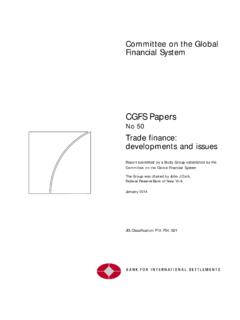Transcription of TRADE, POLICY AND THE ECONOMIC CRISIS - …
1 OECD 2010 trade , POLICY AND THE ECONOMIC CRISIS May 2010 Overview introduction Explaining the " trade collapse" trade -related responses to the CRISIS The effects on trade of CRISIS response measures POLICY implications POLICY recommendations Further reading This report highlights trade POLICY conclusions and recommendations from a major study undertaken by the OECD s trade Committee in response to the financial and ECONOMIC CRISIS that started in 2008. The fall in global trade in 2009 is explained by several factors: the collapse in demand, the drying up of trade finance , a larger fall in demand for highly traded goods (such as machinery and transport equipment) relative to less traded goods and services, and the vertically integrated nature of global supply chains.
2 Early resort to protectionist measures has been relatively muted and does not play a significant part in explaining the fall in trade only about 1% of world imports were affected by new trade restricting measures. The rapid and coordinated G20 response to ensure adequate trade finance was available for viable transactions seems to have been effective. Given their sheer size, stimulus measures taken to rescue sectors of systemic importance (such as banking) or to preserve jobs (as in the automobile industries) or to stimulate growth (such as consumption tax reductions) or buy national measures may be more significant in terms of their potential impact on trade than direct trade POLICY measures.
3 But dollar for dollar, direct trade restricting measures have the most strongly negative impacts on both trade and growth: simulations suggest a USD 1 increase in tariff revenues results in a USD drop in world exports and a USD drop in world income. Simulations also suggest that USD 1 of stimulus spending behind the border can increase a country s own GDP by USD on average while world trade could increase by USD , but the effects on the real GDP of other economies are mixed. These estimated overall impacts depend critically on the nature of the stimulus.
4 Stimulus measures that discriminate between domestic and foreign goods and firms and sector specific measures are clearly less effective. Measures that are most supportive of both trade and growth are non-discriminatory demand stimulus and labour support. Coordination of stimulus measures ensures that benefits are larger and more widely shared. Open markets and the restoration of a level playing field will be a necessary condition for a sustained recovery; this means addressing policies with both direct and indirect impacts on trade .
5 This report recommends: An immediate roll-back of the most trade distorting measures, continued resistance to protectionist pressures, and an ambitious and balanced conclusion of the DDA that will deliver further market opening That governments step back from the exceptional measures taken to support trade finance as conditions normalise Removal of discriminatory provisions from all stimulus measures Restoration of competition POLICY disciplines and withdrawal from the banking sector when the time is judged right with the international coordination needed to avoid regulatory arbitrage.
6 Under current conditions economy-wide demand-side measures to address demand shortfalls and active labour market policies to address unemployment are preferred International coordination of exit from extraordinary measures as ECONOMIC conditions permit; further attention is required both to address specific needs in less developed countries and persistent global macroeconomic imbalances. OECD 2010 2 introduction The ECONOMIC and financial CRISIS of 2008-2009 has prompted an unprecedented level of international cooperation, embodied in deep monetary easing and large fiscal stimulus.
7 The G20 meetings of November 2008, and April and September 2009 produced a synchronised response founded on firm commitments and anti-protectionist pledges, in a continuously broadening international ECONOMIC agenda. In this way, OECD countries have so far avoided the major POLICY mistakes of past crises, such as the protectionist response of the 1930s. Many of the measures taken to stimulate R&D, boost infrastructure spending, lower the tax burden on low-income earners and scale up and strengthen active labour market policies will help contain the long-term damage of the CRISIS for material living standards and welfare.
8 The process of recovery is incomplete, however. GDP and income levels are unlikely to return soon to their initially projected path. Recent OECD estimates put the permanent GDP loss at about three percentage points on average across the OECD, because of long-lasting elevation of risk premia that will raise the cost of capital, as well as persistently higher structural unemployment (OECD, 2010a). The danger going forward is that trade restrictions could build up incrementally, slowly stifling trade and ultimately weakening the effectiveness of the anti-cyclical measures that have been introduced.
9 Protectionist sentiments are likely to increase with persistent unemployment and mounting pressure on government finances. Once put in place protection becomes entrenched and is increasingly difficult to undo, particularly when it prompts retaliatory action by trading partners. Moreover, some time will be needed to address fully the two complex factors that underpinned the CRISIS . To recall briefly, the financial CRISIS , and the subsequent credit crunch and recession, were triggered by rapid credit expansion and under-pricing of risk facilitated by: Major weaknesses in the operation of financial regulatory and supervisory frameworks, including ones that contributed to the build-up of leverage and risk appetite.
10 The current account imbalances that had built up during the past decade and which, through major outflows from surplus countries, helped fuel the rapid credit expansion in deficit countries, allowing them to postpone hard POLICY choices (Obstfeld and Rogoff, 2009, OECD 2009b). In seeking to identify the trade POLICY implications of the CRISIS , and its aftermath, a number of elements need to be addressed: the impact of the CRISIS on trade ; the nature of trade -related POLICY responses to the CRISIS ; and the impact on trade of those POLICY responses.














